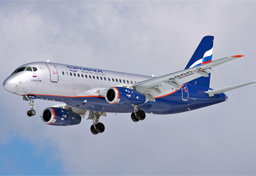Wednesday 12 September 2018
Russia and Iran Discussing Superjets SSJ-100
TEHRAN (Interfax) — Russia and Iran continue to discuss the purchase of Sukhoi Superjet 100 aircraft, the head of the United Aircraft Corporation (UAC) Yuri Slyusar declared.

- Superjet 100-95
- An Aeroflot plane, the main user of the Russian regional jet.
“We are working in this direction, we are discussing with the Iranian companies, but so far I can not report on some kind of contract at this stage”, Slyusar said.
According to him, the parties are eager for a quick deal. “For them (Iran), it is necessary to reduce the number of American components to below 10%”, the head of the UAC said.
In April, during Eurasia Airshow, it was reported that Sukhoi Civil Aircraft JSC (Sukhoi Civil Aircraft, part of PJSC UAC) had signed two framework agreements on the intention to supply 40 Sukhoi Superjet 100 aircraft to Iran in its RRJ-95R version
The Sukhoi Superjet 100, also known by its abbreviation SSJ100, is a fly-by-wire twin-engine regional jet with 8 (VIP) to 108 (all economy) passenger seats. With development initiated in 2000, the airliner was designed and spearheaded by Sukhoi, a division of the United Aircraft Corporation, in co-operation with several foreign partners. Its maiden flight was conducted on 19 May 2008. On 21 April 2011, the Superjet 100 undertook its first commercial passenger flight, on the Armavia route from Yerevan to Moscow.
On 3 February 2011, the Interstate Aviation Committee (IAC IR) granted a Type Certificate for Sukhoi Superjet 100. The Type Certificate confirms compliance of the SSJ100 with the airworthiness regulations and it authorizes the commercial operation of the airliner. On 3 February 2012, the European Aviation Safety Agency (EASA) issued Type Certificate A-176 for the Sukhoi Superjet 100 (model RRJ-95B), confirming that the aircraft complies with the EASA airworthiness and environmental requirements. The certification also makes it possible for airlines operating in countries using EASA rules to accept and operate the aircraft. The extensive validation program included several dedicated flight and ground tests.
The three variants were originally called the RRJ-60, RRJ-75 and RRJ-95, with the numbers designating the average passenger capacity of each type. However, with the renaming of the project to Superjet 100 (or SSJ100 for short), the RRJ-75 was re-labelled the Superjet 100/75, while the RRJ-95 became known as the Superjet 100/95. The smallest variants were postponed, and efforts are currently concentrating on the Superjet 100/95. The basic version SSJ100/95B was certified by EASA on 3 February 2012. The Long Range variant earned certificate on 22 December 2016, with a STOL version SSJ100/95B-100 on 7 March 2017.
Sukhoi claims cash operational costs lower by 8-10% than competitors, reduced fuel burn per seat and higher maintenance intervals. It is designed to compete internationally with its An-148, Embraer E-Jet and Airbus A220 counterparts.

